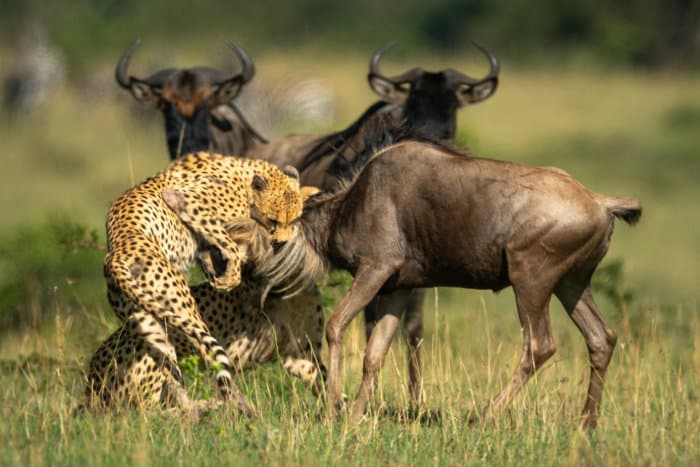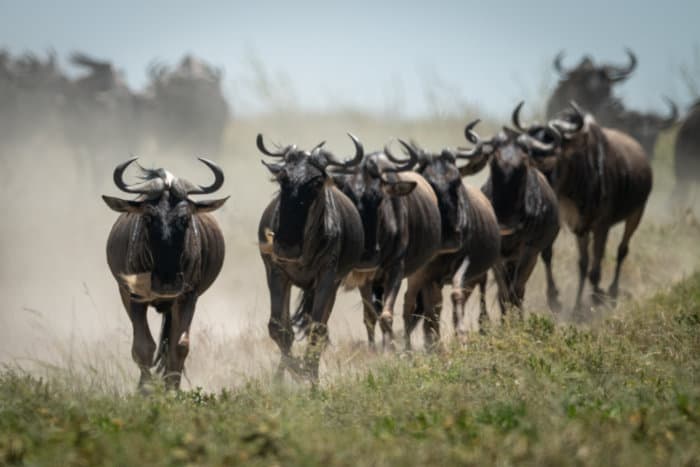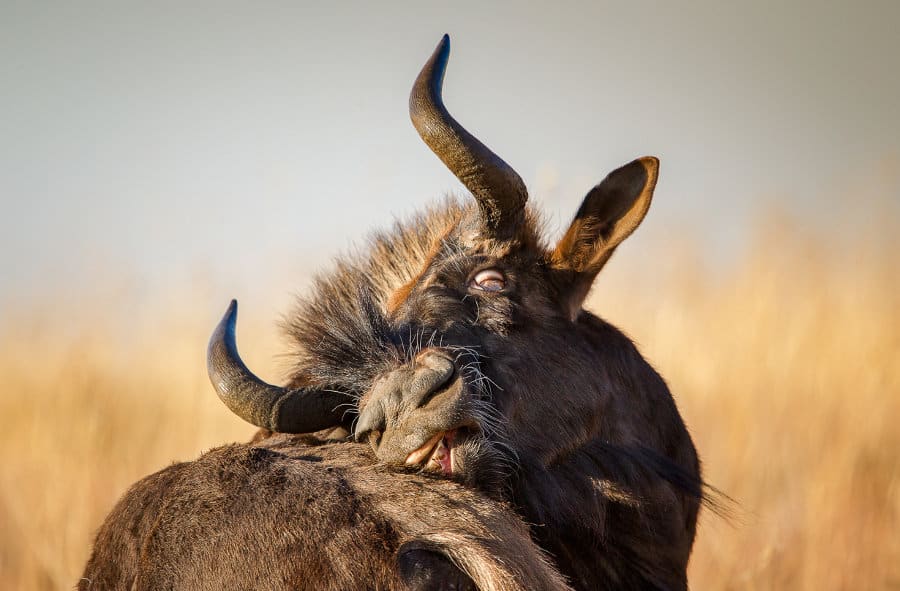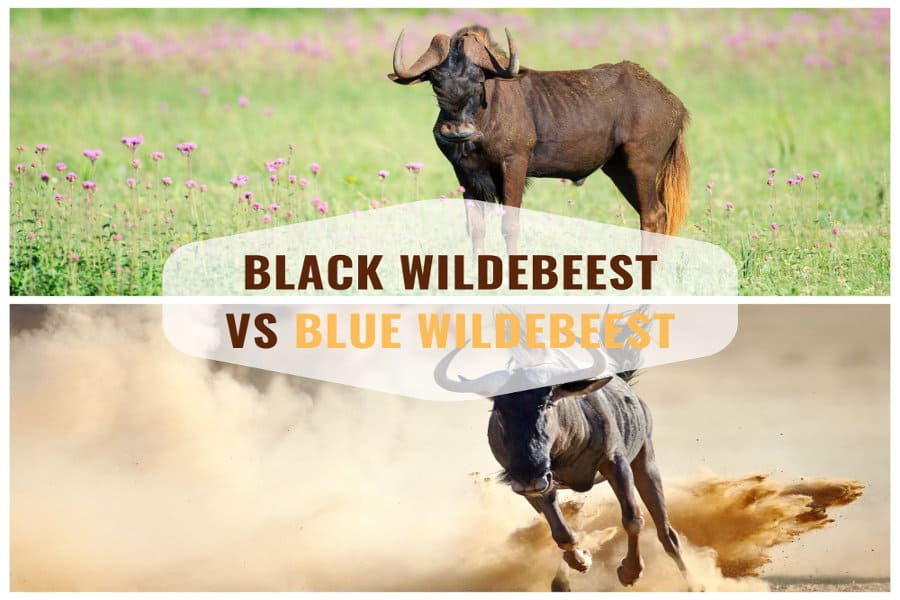With a name as strange as ‘wildebeest’, it is no wonder that many people don’t know much about these animals.
If you’ve watched the Lion King, you would have already seen these animals first hand. Remember the scene where Simba’s dad ‘falls’ into the herd of stampeding animals? Those are blue wildebeest.
Go easy on these gentle giants. Although they can be very dangerous when stampeding, they are a vital part of the African ecosystem. Without wildebeest, the great African migration through the Serengeti just wouldn’t be the same.
Continue reading to find out more about these animals, including their description, habitat, diet, and some interesting animal facts.
What is a Blue Wildebeest?

The blue wildebeest (Connochaetes taurinus), also known as the gnu, is a large bovine animal found in Southern Africa. It is an antelope and is one of two wildebeest species.
The name ‘wildebeest’ is quite strange for anyone who doesn’t speak Afrikaans (a native South African language). Wildebeest translates to ‘wild beast’, and if you see the face of this animal you might begin to understand why.
These animals might not be the prettiest, but they are still worth seeing. Especially if you decide to see them when they gather for their annual migration across Southern Africa — more on this later on.
What Does a Wildebeest Look Like?
As the name suggests, this animal is not going to win a beauty contest any time soon. The characteristically large face is what you first notice when seeing a wildebeest for the first time.
Their face is quite long, with a distinct muzzle that is much darker than the lighter colored hide. They also boast a large shaggy mane, a pointed beard, and sharp, curved horns.
Apart from their face, other key features are their long tail which can measure between 60 – 100 cm.
Don’t let the name fool you — these animals are not blue. The name ‘blue wildebeest’ refers to the silvery-blue sheen of the animal’s coat.
Blue wildebeest size

One of the first things you should know is that this is no small animal. When you see them standing out in the grasslands, they will be between 115 – 145 cm tall.
Their length, measured from their head to the end of their body, is between 170 – 240 cm.
How much does a wildebeest weigh?
Male blue wildebeest can reach up to 290 kg, with females rarely exceeding 260 kg. The heaviest male ever recorded was in Kruger National Park and weighed 307.5 kg.
Calves usually weigh about 19 kg at birth, but they are fast growers and within 6 months are already able to fend for themselves.
Wildebeest lifespan

The lifespan of a wildebeest is on average 20 years in the wild. The formative years of a wildebeest’s life are the most important. If it is able to survive into adulthood, it will have an increased chance of survival.
There are many blue wildebeest kept in captivity in nature reserves or private farms. In these conditions, wildebeest can live to reach 21 years of age. This is largely due to decreased risk from predators and diseases.
What Do Wildebeest Eat?
Now that you know how heavy they are, you must be wondering what they eat. Like with many large African animals, blue wildebeest are herbivores.
The wildebeest’s favorite food is the short grass found in Central, Eastern, and Southern Africa. Although they prefer grass, when there is a shortage they will switch to eating foliage from shrubs or trees.
The blue wildebeest’s large mouth allows it to grab large tufts of grass at a time. These animals are often found living alongside zebras. Zebras eat the top, less-nutritious grass, which helps reveal the greener grass that the wildebeest prefer.
These animals travel in large herds to find food. Their annual migration is due to their search for new grasslands in the North brought on by the onset of the rainy season.
Wildebeest predators

While on the topic of food, there are many animals that would gladly make a meal out of this large herbivore. These animals are abundant, making them a perfect target for lions, cheetahs, leopards, wild dogs, hyenas, and crocodiles.
Their target as a food source makes the blue wildebeest migration a great opportunity to see predators. These predators are usually never too far behind the herd.
The most dangerous time for wildebeest is when they are young. Newborn wildebeest must keep up with the herd within minutes of birth. Any delay can mean an easy meal for predators lurking nearby.
What is the Geographic Range of a Blue Wildebeest?
The blue wildebeest’s geographic range is in Africa. These animals live where they can find food, in the Southern, Central, and Eastern African grasslands and open woodlands.
Wildebeest are native to Africa, however, there are two countries in particular that are the best for viewing these animals — Tanzania and Kenya.
The Serengeti in Northern Tanzania is an especially incredible part of Africa where you can see these animals roaming wild without any interference from man. It is also the start of their great migration.
After staying in Tanzania for about half the year, they spend the other half of the year in Kenya waiting for the rains to return.
Great Migration of Blue Wildebeest
Every year, one of the greatest natural events takes place in Southern Africa — the great migration. Blue wildebeest are one of the main participants.
It is unsure exactly how many animals take part, however, there are at least over 2 million. Of these animals, there are approximately 1.5 million blue wildebeest. If you are looking to see wildebeest, there is no other place with this many on offer.
The migration is not only a great place to see wildebeest roaming, it is also one of most spectacular events in the world. Zebra, antelope, lion, cheetah, crocodiles, and many more animals are on display as they all go in pursuit of food.
Why do wildebeest migrate?

These ‘wild beasts’ are animals that migrate for food. When the rains end and the grasslands start drying up, they need to find a new place to eat.
Between February and May, they spend their time mating. When the rains start ending in May, the animals need to go in search of new grasslands. This eventually leads them across the Grumeti and Mara rivers, and ultimately into Kenya.
The wildebeest then remain in Kenya for the remainder of the dry season until they return back to the Serengeti around December — with time to spare before the next calving season starts in February.
During this impressive journey, the average wildebeest distance traveled is 800 km. It’s not an easy journey, though, and up to 250,000 wildebeest die from exhaustion, hunger, thirst, and predation.
Wildebeest Mating
Wildebeest become sexually mature at 2 years of age. Females can, however, reproduce from 16 months if they have been adequately nourished.
The wildebeest mating season is between February and May every year. The gestation period is 8.5 months and almost all of the calves are born in a 2 – 3 week period. As many as 500,000 calves are born during this time.
Males will face off against one another and the dominant males will win the right to mate. Females will often mate with multiple males in one year.
Wildebeest Facts

There are so many interesting things to learn about blue wildebeest that it can be difficult to remember it all. To help you, here is a list of the top 7 facts about blue wildebeest.
- Blue wildebeest can run up to 40 mph.
- During their annual migration, blue wildebeest have to cross TWO crocodile infested rivers.
- Not all blue wildebeest migrate. There are sometimes smaller herds – usually 10 females and their offspring – which remain in Tanzania year-round. The females in these herds are usually territorial and will drive away outsiders who try to join them.
- Territorial males will engage in ‘twist fighting’, where both males try to throw one another off balance.
- A group of blue wildebeest is referred to as a ‘herd’.
- Blue wildebeest are an animal of ‘least concern’ according to the IUCN red list status.
- By staying in large herds, blue wildebeest use their massive numbers to protect themselves from predators.
Where Will the Wildebeest Go Next?
Although they might not be changing their migration any time soon, there are so many blue wildebeest found in Africa that you are guaranteed some amazing sightings.
These intriguing animals have been calling the grasslands of Africa their home for many years and will hopefully continue to do so for many more. Whether you opt to see them in a game reserve or in the Serengeti — there are plenty of places to find them.
These unique animals are a symbol of Africa wildlife and you are only a few clicks away from booking a safari to see them.



